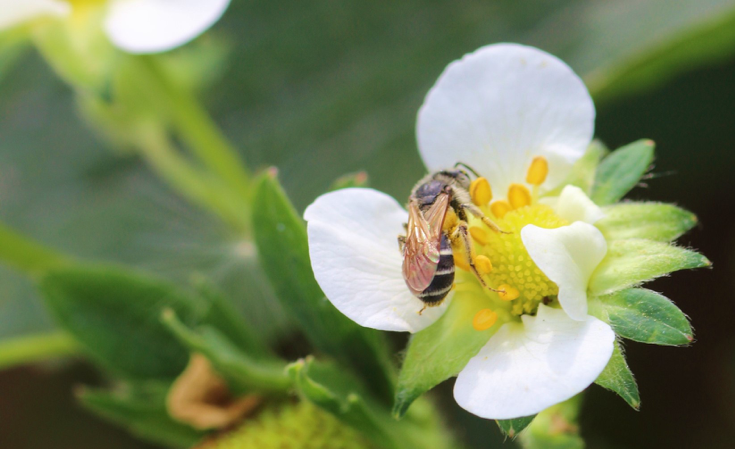 Evolution & Behaviour
Evolution & Behaviour
The berries and the bees: wild bees do it better
Many commercial strawberry varieties grow bigger and better when pollinated by bees. However, not all bee species are created equal in terms of strawberry pollination. Our study explored the influence of wild and managed pollination on strawberry size.

Even though that there are more than 20,000 species of bees worldwide, the word "bee" often invokes images of a hive-dwelling, golden-liquid-generating insect. Although honey bees have been stealing the spotlight for quite some time, most bee species are wild, unmanaged, and do not produce honey or live in hives. Among these wild bee species, there are many better (and more endangered) pollinators than the European honey bee (Apis mellifera L.), the most widely managed crop pollinator.
To give our wild, unmanaged bees a chance to prove their pollination skills, we decided to test the performance of some of our local species against that of managed honey bees. We decided to use strawberry as the pollination test crop because strawberries are delicious and we knew our experiment would produce lots of edible results. Also, strawberry is an ideal crop in which to study pollination because you can assess how well a strawberry has been pollinated directly from the fruit. Those little "seeds" you see on the outside of the strawberry are individual little fruits (called achenes) and all of these achenes need to be fertilized through pollination to produce a fully-formed, marketable strawberry. If a strawberry flower is not pollinated very well, a tiny, malformed berry will be produced.
The vast diversity of sizes, shapes, hairiness, life cycles, and foraging preferences among bee species creates differences in their pollen transport and delivery capabilities. In an investigation of pollinator performance, we have to consider not only the amount of pollen delivered to a flower, but also the quality of that pollen. Some flowers contain their own pollen and can fertilize themselves (self-pollination). But! Pollen transported to a flower from another plant (cross-pollination), is of higher quality and usually produces fruit or seed that is bigger and better than that of self-pollinated flowers.
To find out which bees transported the most, and the highest-quality pollen to strawberry flowers, we first developed a new way to measure the pollen deposited by each bee that visits a flower. Then we conducted our experiment by going to a strawberry farm and closely monitoring and manipulating the type of bees that visited the flowers. We allowed some flowers to be visited only by honey bees and some only by wild bees. After each bee left a flower we measured the amount of pollen deposited and then covered our flowers with special mesh bags so no other bees could visit them. Once our flowers had developed into strawberries, we assessed pollen quality by the weight and shape of the strawberry.
The flower visits by the wild bees were too diverse to determine exactly which wild species was the best strawberry pollinator, but we found that strawberries visited by wild bees, in general, were much larger than those visited by honey bees. However, we found that both wild and honey bees deposited similar amounts of pollen, so pollen quantity was not responsible for differences in berry size. Our results suggest that the wild bee community provided more cross-pollination to strawberry flowers than the managed honey bees on the farm where we conducted our research (Quebec, Canada). Thus, if honey bees are provided in abundance in strawberry fields, they may usurp flowers that could have been more effectively pollinated by wild bees. BUT for growers to take advantage of this bigger-berry pollination, there would need to be abundant wild bee populations on their farms, which is not always the case. Maintaining wild bee habitat on agricultural lands, such as bare patches of untilled earth, providing floral resources when the crop is not in bloom, and preserving natural areas around crops may prove beneficial for growers, wild bees, and strawberry consumers alike.
Original Article:
G. MacInnis, J. R. K. Forrest, Pollination by wild bees yields larger strawberries than pollination by honey bees. Journal of Applied Ecology 56, 824-832 (2019)Edited by:
Massimo Caine , Founder and Director
We thought you might like
Bee aware! Signs of a global decline in wild bee diversity
Oct 14, 2021 in Earth & Space | 3.5 min read by Eduardo E. ZattaraViruses are spilling over from managed honey bees to wild bumble bees
Mar 13, 2020 in Evolution & Behaviour | 4 min read by Samantha A. AlgerMore from Evolution & Behaviour
Cicada emergence alters forest food webs
Jan 31, 2025 in Evolution & Behaviour | 3.5 min read by Martha Weiss , John LillSize does not matter: direct estimations of mutation rates in baleen whales
Jan 29, 2025 in Evolution & Behaviour | 4 min read by Marcos Suárez-MenéndezThe Claws and the Spear: New Evidence of Neanderthal-Cave Lion Interactions
Jan 22, 2025 in Evolution & Behaviour | 3.5 min read by Gabriele RussoA deep-sea spa: the key to the pearl octopus’ success
Jan 20, 2025 in Evolution & Behaviour | 3.5 min read by Jim BarryFeisty fish and birds with attitude: Why does evolution not lead to identical individuals?
Aug 31, 2024 in Evolution & Behaviour | 3 min read by Lukas Eigentler , Klaus Reinhold , David KikuchiEditor's picks
Trending now
Popular topics


